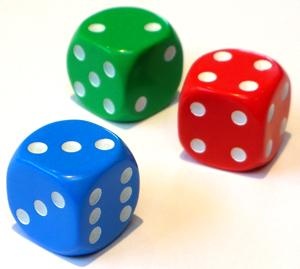There has been enough interest that I think we can formally declare Rota’s Basis Conjecture to be Polymath 12. I am told that it is standard Polymath practice to start a new blog post whenever the number of comments reaches about 100, and we have reached that point, so that is one reason I am writing a second post at this time. I am also told that sometimes, separate “discussion” and “research” threads are created; I’m not seeing an immediate need for such a separation yet, and so I am not going to state a rule that comments of one type belong under the original post whereas comments of some other type belong under this new post. I will just say that if you are in doubt, I recommend posting new comments under this post rather than the old one, but if common sense clearly says that your comment belongs under the old post then you should use common sense.
The other reason to create a new post is to take stock of where we are and perhaps suggest some ways to go forward. Let me emphasize that the list below is not comprehensive, but is meant only to summarize the comments so far and to throw in a few ideas of my own. Assuming this project continues to gather steam, the plan is to populate the associated Polymath Wiki page with a more comprehensive list of references and statements of partial results. If you have an idea that does not seem to fit into any of the categories below, please consider that to be an invitation to leave a comment about your idea, not an indication that it is not of interest!
Matroids with No Small Circuits
I want to start with an idea that I mentioned in my MathOverflow post but not in my previous Polymath Blog post. I think it is very promising, and I don’t think many people have looked at it. Geelen and Humphries proved that Rota’s Basis Conjecture is true for paving matroids. In the case of vector spaces, what this means is that they proved the conjecture in the case where every (n – 1)-element subset of the given set of n2 vectors is linearly independent. It is natural to ask if n – 1 can be reduced to n – 2. I have not digested the Geelen–Humphries paper so I do not know how easy or hard this might be, but it certainly could not hurt to have more people study this paper and make an attempt to extend its results. If an oracle were to tell me that Rota’s Basis Conjecture has a 10-page proof and were to ask me what I thought the method was, then at this point in time I would guess that the proof proceeds by induction on the size of the smallest circuit. Even if I am totally wrong, I think we will definitely learn something by understanding exactly why this approach cannot be extended.
Independent Partial Transversals
Let me now review the progress on the three ideas I mentioned in my first blog post. In Idea 1, I asked if the n2 vectors could be partitioned into at most 2n – 2 independent partial transversals. A nice proof that the answer is yes was given by domotorp. Eli Berger then made a comment that suggested that the topological methods of Aharoni and Berger could push this bound lower, but there was either an error in his suggestion or we misunderstood it. It would be good to get this point clarified. I should also mention that Aharoni mentioned to me offline that he unfortunately could not participate actively in Polymath but that he did have an answer to my question about their topological methods, which is that the topological concepts they were using were intrinsically not strong enough to bring the bound down to n + 1, let alone n. It might nevertheless be valuable to understand exactly how far we can go by thinking about independent partial transversals. Ron Aharoni and Jonathan Farley both had interesting ideas along these lines; rather than reproduce them here, let me just say that you can find Aharoni’s comment (under the previous blog post) by searching for “Vizing” and Farley’s comment by searching for “Mirsky.”
Local Obstructions
Idea 2 was to look for additional obstructions to natural strengthenings of Rota’s Basis Conjecture, by computationally searching for counterexamples that arise if the number of columns is smaller than the number of rows. Luke Pebody started such a search but reported a bug. I still believe that this computational search is worth doing, because I suspect that any proof that Rota’s Basis Conjecture holds for all matroids is going to have to come to grips with these counterexamples.
Note that if we are interested just in vector spaces, we could do some Gröbner basis calculations. I am not sure that this would be any less computationally intensive than exhausting over all small matroids, but it might reveal additional structure that is peculiar to the vector space case.
Algebraic Geometry
There has been minimal progress in this (admittedly vague) direction. I will quote Ellenberg’s initial thoughts: “If you were going to degenerate, what you would need to do is say: is there any version of this question that makes sense when the basic object is, instead of a basis of an n-dimensional vector space V, a 0-dimensional subscheme of V of degree n which is not contained in any hyperplane? For instance, in 2-space you could have something which was totally supported at the point (0,1) but which was “fat” in the horizontal direction of degree 2. This is the scheme S such that what it means for a curve C to contain S is that S passes through (0,1) and has a horizontal tangent there.”
Let me also mention that Jan Draisma sent me email recently with the following remarks: “A possible idea would be to consider a counterexample as lying in some suitable equivariant Hilbert scheme in which being a counterexample is a closed condition, then degenerate to a counterexample stable under a Borel subgroup of GLn, and come to a contradiction. ‘Equivariant’ should reflect the action of GLn × (Sn ⋉ Snn). However, I have not managed to make this work myself, even in low dimensions. In fact, having a good algebro-geometric argument for the n = 3 case, rather than a case-by-case analysis, would already be very nice!”
Alon–Tarsi Conjecture
Now let me move on to other ideas suggested in the comments. There were several thoughts about the Alon–Tarsi Conjecture that the Alon–Tarsi constant Lneven – Lnodd ≠ 0 when n is even. Rebecca Stones gave a formula that, as Gil Kalai observed, equated the Alon–Tarsi constant with the top Fourier–Walsh coefficient for the function detn; i.e., up to sign, the Alon–Tarsi constant is
ΣA (–1)σ(A) det(A)n,
where the sum is over all zero-one matrices and σ(A) is the number of zero entries in A. This formula suggests various possibilities. For example one could try to prove that Lneven – Lnodd ≢ 0 (mod p) where p = 2n + 1 is prime, because in this case, det(A)n must be 0, 1, or –1. This would already be a new result for n = 26, and the case n = 6 is small enough to compute explicitly and look for inspiration. Luke Pebody posted the results of some computations in this case.
Another possibility, suggested by Gil Kalai, is to consider a Gaussian analogue. Instead of random zero-one matrices, consider random Gaussian matrices and try to understand the Hermite expansion of detn, in particular showing that the coefficient corresponding to all ones is nonzero. This might be easier and might give some insight.
Note also that in the comments to my MathOverflow post, Abdelmalek Abdesselam proposed an analogue of the Alon–Tarsi conjecture for odd n. I do not think that many people have looked at this.
Generalizations and Special Cases
Some generalizations and special cases of the conjecture were mentioned in the comments. Proving the conjecture for graphic matroids or binary matroids would be an enormous advance. There is a generalization due to Jeff Kahn, in which we have n2 bases Bij and we have to pick vij ∈ Bij to form an n × n grid whose rows and columns are all bases. Another generalization was prompted by a remark by David Eppstein: Suppose we are given n bases B1, …, Bn of a vector space of dimension m ≤ n, and suppose we are given an n × n zero-one matrix with exactly m 1’s in every row and column. Can we replace each 1 in the matrix with a vector in such a way that the m vectors in row i are the elements of Bi and such that the m vectors in every column form a basis?
Juan Sebastian Lozano suggested the following reformulation: Does there exist a group G such that V is a representation of G and there exists gi ∈ G such that gi Bi = Bi+1, and for every vector b ∈ B1,
span{g0b, …, gn – 1b} = V
where gi = gi … g1 and g0 is the identity?
Other Ideas
Fedor Petrov mentioned a theorem by him and Roman Karasev that looks potentially relevant (or at least the method of proof might be useful). Let p be an odd prime, and let V be the Fp-vector space of dimension k. Denote V* = V \ {0} and put m = |V*|/2 = (pk – 1)/2. Suppose we are given m linear bases of the vector space V
(v11, …, v1k), (v21, …, v2k), …, (vm1, …, vmk).
Then there exist pairwise distinct x1, …, xm, y1, …, ym ∈ V* and a map g:[m] → [k] such that for every i ∈ {1, …, m} we have yi – xi = vig(i).
Gil Kalai notes that the Alon–Tarsi conjecture is related to the coloring polynomial of a graph and asks if we can learn anything by considering more general polynomials such as
Π {(xi – λexj) : i < j, {i,j} = e ∈ E(G)},
where the λe are weights associated to the edges e.


